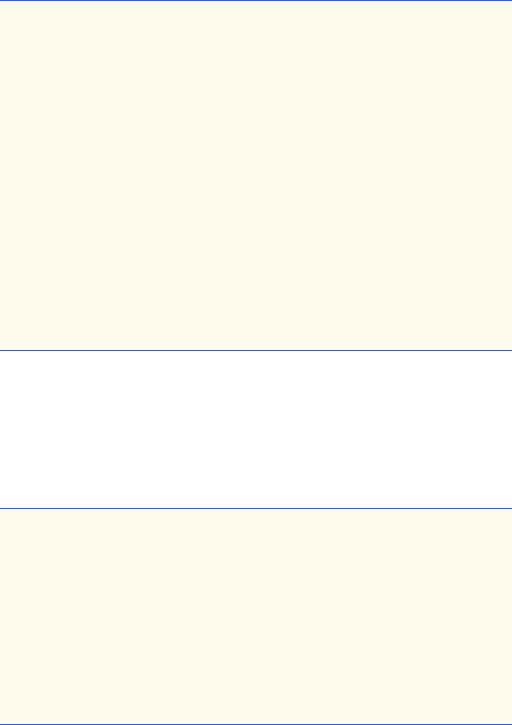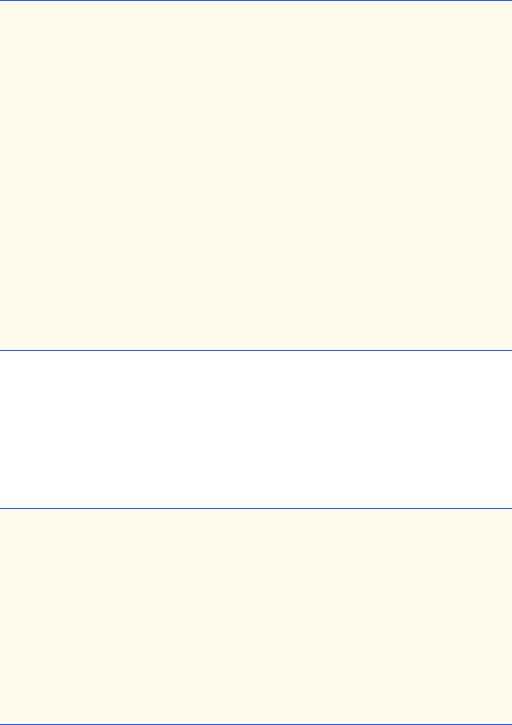
- •Contents
- •Preface
- •Introduction to Computers, the Internet and the Web
- •1.3 Computer Organization
- •Languages
- •1.9 Java Class Libraries
- •1.12 The Internet and the World Wide Web
- •1.14 General Notes about Java and This Book
- •Sections
- •Introduction to Java Applications
- •2.4 Displaying Text in a Dialog Box
- •2.5 Another Java Application: Adding Integers
- •2.8 Decision Making: Equality and Relational Operators
- •Introduction to Java Applets
- •3.2 Sample Applets from the Java 2 Software Development Kit
- •3.3 A Simple Java Applet: Drawing a String
- •3.4 Two More Simple Applets: Drawing Strings and Lines
- •3.6 Viewing Applets in a Web Browser
- •3.7 Java Applet Internet and World Wide Web Resources
- •Repetition)
- •Class Attributes
- •5.8 Labeled break and continue Statements
- •5.9 Logical Operators
- •Methods
- •6.2 Program Modules in Java
- •6.7 Java API Packages
- •6.13 Example Using Recursion: The Fibonacci Series
- •6.16 Methods of Class JApplet
- •Class Operations
- •Arrays
- •7.6 Passing Arrays to Methods
- •7.8 Searching Arrays: Linear Search and Binary Search
- •Collaboration Among Objects
- •8.2 Implementing a Time Abstract Data Type with a Class
- •8.3 Class Scope
- •8.4 Controlling Access to Members
- •8.5 Creating Packages
- •8.7 Using Overloaded Constructors
- •8.9 Software Reusability
- •8.10 Final Instance Variables
- •Classes
- •8.16 Data Abstraction and Encapsulation
- •9.2 Superclasses and Subclasses
- •9.5 Constructors and Finalizers in Subclasses
- •Conversion
- •9.11 Type Fields and switch Statements
- •9.14 Abstract Superclasses and Concrete Classes
- •9.17 New Classes and Dynamic Binding
- •9.18 Case Study: Inheriting Interface and Implementation
- •9.19 Case Study: Creating and Using Interfaces
- •9.21 Notes on Inner Class Definitions
- •Strings and Characters
- •10.2 Fundamentals of Characters and Strings
- •10.21 Card Shuffling and Dealing Simulation
- •Handling
- •Graphics and Java2D
- •11.2 Graphics Contexts and Graphics Objects
- •11.5 Drawing Lines, Rectangles and Ovals
- •11.9 Java2D Shapes
- •12.12 Adapter Classes
- •Cases
- •13.3 Creating a Customized Subclass of JPanel
- •Applications
- •Controller
- •Exception Handling
- •14.6 Throwing an Exception
- •14.7 Catching an Exception
- •Multithreading
- •15.3 Thread States: Life Cycle of a Thread
- •15.4 Thread Priorities and Thread Scheduling
- •15.5 Thread Synchronization
- •15.9 Daemon Threads
- •Multithreading
- •Design Patterns
- •Files and Streams
- •16.2 Data Hierarchy
- •16.3 Files and Streams
- •Networking
- •17.2 Manipulating URIs
- •17.3 Reading a File on a Web Server
- •17.4 Establishing a Simple Server Using Stream Sockets
- •17.5 Establishing a Simple Client Using Stream Sockets
- •17.9 Security and the Network
- •18.2 Loading, Displaying and Scaling Images
- •18.3 Animating a Series of Images
- •18.5 Image Maps
- •18.6 Loading and Playing Audio Clips
- •18.7 Internet and World Wide Web Resources
- •Data Structures
- •19.4 Linked Lists
- •20.8 Bit Manipulation and the Bitwise Operators
- •Collections
- •21.8 Maps
- •21.9 Synchronization Wrappers
- •21.10 Unmodifiable Wrappers
- •22.2 Playing Media
- •22.3 Formatting and Saving Captured Media
- •22.5 Java Sound
- •22.8 Internet and World Wide Web Resources
- •Hexadecimal Numbers

Chapter 9 |
Object-Oriented Programming |
473 |
a program that need modification are those parts that require direct knowledge of the particular class that is added to the hierarchy. We will study two substantial class hierarchies and will show how objects throughout those hierarchies are manipulated polymorphically.
9.11 Type Fields and switch Statements
One means of dealing with objects of many different types is to use a switch statement to take an appropriate action on each object, based on that object’s type. For example, in a hierarchy of shapes in which each shape has a shapeType instance variable, a switch structure could determine which print method to call based on the object’s shapeType.
There are many problems with using switch logic. The programmer might forget to make such a type test when one is warranted. The programmer might forget to test all possible cases in a switch. If a switch-based system is modified by adding new types, the programmer might forget to insert the new cases in existing switch statements. Every addition or deletion of a class demands that every switch statement in the system be modified; tracking these down can be time consuming and error prone.
As we will see, polymorphic programming can eliminate the need for switch logic. The programmer can use Java’s polymorphism mechanism to perform the equivalent logic automatically, thus avoiding the kinds of errors typically associated with switch logic.
Testing and Debugging Tip 9.2
An interesting consequence of using polymorphism is that programs take on a simplified appearance. They contain less branching logic in favor of simpler sequential code. This simplification facilitates testing, debugging, and program maintenance.
9.12 Dynamic Method Binding
Suppose a set of shape classes such as Circle, Triangle, Rectangle, Square, are all derived from superclass Shape. In object-oriented programming, each of these classes might be endowed with the ability to draw itself. Each class has its own draw method, and the draw method implementation for each shape is quite different. When drawing a shape, whatever that shape may be, it would be nice to be able to treat all these shapes generically as objects of the superclass Shape. Then, to draw any shape, we could simply call method draw of superclass Shape and let the program determine dynamically (i.e., at execution time) which subclass draw method to use from the actual object’s type.
To enable this kind of behavior, we declare draw in the superclass, and then we override draw in each of the subclasses to draw the appropriate shape.
 Software Engineering Observation 9.16
Software Engineering Observation 9.16
 When a subclass chooses not to redefine a method, the subclass simply inherits its immediate
When a subclass chooses not to redefine a method, the subclass simply inherits its immediate  superclass’s method definition.
superclass’s method definition.
If we use a superclass reference to refer to a subclass object and invoke the draw method, the program will choose the correct subclass’s draw method dynamically (i.e., at execution time). This is called dynamic method binding. Dynamic method binding is an important mechanism for implementing polymorphic processing of objects and will be illustrated in the case studies later in this chapter
© Copyright 1992–2002 by Deitel & Associates, Inc. All Rights Reserved. 7/7/01

474 |
Object-Oriented Programming |
Chapter 9 |
9.13 final Methods and Classes
We saw in Chapter 7 that variables can be declared final to indicate that they cannot be modified after they are declared and that they must be initialized when they are declared. It is also possible to define methods and classes with the final modifier.
A method that is declared final cannot be overridden in a subclass. Methods that are declared static and methods that are declared private are implicitly final. Because a final method’s definition can never change, the compiler can optimize the program by removing calls to final methods and replacing them with the expanded code of their definitions at each method call location—a technique known as inlining the code.
A class that is declared final cannot be a superclass (i.e., a class cannot inherit from a final class). All methods in a final class are implicitly final.
Performance Tip 9.2

 The compiler can decide to inline a final method call and will do so for small, simple fi-
The compiler can decide to inline a final method call and will do so for small, simple fi-  nal methods. Inlining does not violate encapsulation or information hiding (but does improve performance because it eliminates the overhead of making a method call).
nal methods. Inlining does not violate encapsulation or information hiding (but does improve performance because it eliminates the overhead of making a method call).
 Software Engineering Observation 9.17
Software Engineering Observation 9.17
A class declared final cannot be extended, and every method in it is implicitly final.
 Software Engineering Observation 9.18
Software Engineering Observation 9.18
 In the Java API, the vast majority of the thousands of classes are not declared final. This
In the Java API, the vast majority of the thousands of classes are not declared final. This  enables inheritance and polymorphic processing—the fundamental capabilities of objectoriented programming. However, in some cases it is important to declare classes final— typically for security1 or performance reasons.
enables inheritance and polymorphic processing—the fundamental capabilities of objectoriented programming. However, in some cases it is important to declare classes final— typically for security1 or performance reasons.
9.14 Abstract Superclasses and Concrete Classes
When we think of a class as a type, we assume that objects of that type will be instantiated. However, there are cases in which it is useful to define classes for which the programmer never intends to instantiate any objects. Such classes are called abstract classes. Because these are used as superclasses in inheritance situations, we will normally refer to them as abstract superclasses. No objects of abstract superclasses can be instantiated.
The sole purpose of an abstract class is to provide an appropriate superclass from which other classes may inherit interface and/or implementation (we will see examples of each shortly). Classes from which objects can be instantiated are called concrete classes.
1.Class String is an example of a final class. This class cannot be extended, so programs that use Strings can rely on the functionality of String objects as specified in the Java API. Making the class final also prevents programmers from creating subclasses that might bypass security restrictions. For example, when a Java program attempts to open a file on your computer, the program supplies a String representing the name of the file. In many cases, opening a file is subject to security restrictions. If it were possible to create a subclass of String, that subclass might be implemented in a manner that enables it to specify one String to pass a security or permissions test, then specify a different name when the program actually opens the file. For more information on final classes and methods visit: java.sun.com/docs/books/tutorial/ java/javaOO/final.html [Note: Strings are covered in detail in Chapter 10 and file processing is covered in detail in Chapter 16.]
©Copyright 1992–2002 by Deitel & Associates, Inc. All Rights Reserved. 7/7/01
Chapter 9 |
Object-Oriented Programming |
475 |
We could have an abstract superclass TwoDimensionalObject and derive concrete classes, such as Square, Circle, Triangle. We could also have an abstract superclass ThreeDimensionalObject and derive such concrete classes as Cube, Sphere and Cylinder. Abstract superclasses are too generic to define real objects; we need to be more specific before we can think of instantiating objects. For example, if someone tells you to “draw the shape,” what shape would you draw? Concrete classes provide the specifics that make it reasonable to instantiate objects.
A class is made abstract by declaring it with keyword abstract. A hierarchy does not need to contain any abstract classes, but, as we will see, many good object-oriented systems have class hierarchies headed by abstract superclasses. In some cases, abstract classes constitute the top few levels of the hierarchy. A good example of this is the shape hierarchy in Fig. 9.3. The hierarchy begins with abstract superclass Shape. On the next level down we have two more abstract superclasses, namely
TwoDimensionalShape and ThreeDimensionalShape. The next level down would start defining concrete classes for such two-dimensional shapes as Circle and Square and for such three-dimensional shapes as Sphere and Cube.
9.15 Polymorphism Examples
Here is an example of polymorphism. If class Rectangle is derived from class Quadrilateral, then a Rectangle object is a more specific version of a Quadrilateral object. An operation (such as calculating the perimeter or the area) that can be performed on an object of class Quadrilateral can also be performed on an object of class Rectangle. Such operations can also be performed on other “kinds of” Quadrilaterals, such as Squares, Parallelograms and Trapezoids. When a request is made through a superclass reference to use a method, Java chooses the correct overridden method polymorphically in the appropriate subclass associated with the object.
Here is another example of polymorphism. Suppose we have a video game that manipulates objects of many varieties, including objects of class Martian, Venutian, Plutonian, SpaceShip, LaserBeam and the like. Each of these classes extends a common superclass, GamePiece, that contains a method called drawYourself. This method is defined by each subclass. A Java screen manager program would simply maintain some kind of collection (such as a GamePiece array) of references to objects of these various classes. To refresh the screen periodically, the screen manager would simply send each object the same message, namely drawYourself. Each object would respond in its own unique way. A Martian object would draw itself with the appropriate number of antennae. A SpaceShip object would draw itself bright and silvery. A LaserBeam object would draw itself as a bright red beam across the screen. Thus, the same message sent to a variety of objects would have “many forms” of results—hence the term polymorphism.
Such a polymorphic screen manager makes it especially easy to add new types of objects to a system with minimal impact. Suppose we want to add Mercurians to our video game. We certainly have to build a new class Mercurian that extends GamePiece and provides its own definition of the drawYourself method. Then, when objects of class Mercurian appear in the collection, the screen manager need not be modified. It simply sends the message drawYourself to every object in the collection
© Copyright 1992–2002 by Deitel & Associates, Inc. All Rights Reserved. 7/7/01

476 |
Object-Oriented Programming |
Chapter 9 |
regardless of the object’s type, so the new Mercurian objects just “fit right in.” Thus, with polymorphism, new types of objects not even envisioned when a system is created can be added without modifications to the system (other than the new class itself, of course).
Through the use of polymorphism, one method call can cause different actions to occur, depending on the type of the object receiving the call. This gives the programmer tremendous expressive capability. We will see examples of the power of polymorphism in the next several sections.
 Software Engineering Observation 9.19
Software Engineering Observation 9.19
 With polymorphism, the programmer can deal in generalities and let the execution-time en-
With polymorphism, the programmer can deal in generalities and let the execution-time en-  vironment concern itself with the specifics. The programmer can command a wide variety of objects to behave in manners appropriate to those objects without even knowing the types of those objects.
vironment concern itself with the specifics. The programmer can command a wide variety of objects to behave in manners appropriate to those objects without even knowing the types of those objects.
 Software Engineering Observation 9.20
Software Engineering Observation 9.20
 Polymorphism promotes extensibility: Software written to invoke polymorphic behavior is
Polymorphism promotes extensibility: Software written to invoke polymorphic behavior is  written independent of the types of the objects to which messages (i.e., method calls) are sent. Thus, new types of objects that can respond to existing messages can be added into such a system without modifying the base system.
written independent of the types of the objects to which messages (i.e., method calls) are sent. Thus, new types of objects that can respond to existing messages can be added into such a system without modifying the base system.
 Software Engineering Observation 9.21
Software Engineering Observation 9.21
 If a method is declared final, it cannot be overridden in subclasses, so method calls may
If a method is declared final, it cannot be overridden in subclasses, so method calls may  not be sent polymorphically to objects of those subclasses. The method call may still be sent to subclasses, but they will all respond identically rather than polymorphically.
not be sent polymorphically to objects of those subclasses. The method call may still be sent to subclasses, but they will all respond identically rather than polymorphically.
 Software Engineering Observation 9.22
Software Engineering Observation 9.22
 An abstract class defines a common interface for the various members of a class hierar-
An abstract class defines a common interface for the various members of a class hierar-  chy. The abstract class contains methods that will be defined in the subclasses. All classes in the hierarchy can use this same interface through polymorphism.
chy. The abstract class contains methods that will be defined in the subclasses. All classes in the hierarchy can use this same interface through polymorphism.
Although we cannot instantiate objects of abstract superclasses, we can declare references to abstract superclasses. Such references can be used to enable polymorphic manipulations of subclass objects when such objects are instantiated from concrete classes.
Let us consider more applications of polymorphism. A screen manager needs to display a variety of objects, including new types of objects that will be added to the system even after the screen manager is written. The system may need to display various shapes (the superclass is Shape), such as Circle, Triangle and Rectangle. Each shape class is derived from superclass Shape. The screen manager uses superclass Shape references to manage the objects to be displayed. To draw any object (regardless of the level at which that object appears in the inheritance hierarchy), the screen manager uses a superclass reference to the object and simply sends a draw message to the object. Method draw has been declared abstract in superclass Shape and has been overridden in each of the subclasses. Each Shape object knows how to draw itself. The screen manager does not have to worry about what type each object is or whether the screen manager has seen objects of that type before—the screen manager simply tells each object to draw itself.
Polymorphism is particularly effective for implementing layered software systems. In operating systems, for example, each type of physical device could operate quite differently from the others. Even so, commands to read or write data from and to devices can have a
© Copyright 1992–2002 by Deitel & Associates, Inc. All Rights Reserved. 7/7/01

Chapter 9 |
Object-Oriented Programming |
477 |
certain uniformity. The write message sent to a device-driver object needs to be interpreted specifically in the context of that device driver and how that device driver manipulates devices of a specific type. However, the write call itself is really no different from the write to any other device in the system—simply place some number of bytes from memory onto that device. An object-oriented operating system might use an abstract superclass to provide an interface appropriate for all device drivers. Then, through inheritance from that abstract superclass, subclasses are formed that all operate similarly. The capabilities (i.e., the public interface) offered by the device drivers are provided as abstract methods in the abstract superclass. The implementations of these abstract methods are provided in the subclasses that correspond to the specific types of device drivers.
It is common in object-oriented programming to define an iterator class that can walk through all the objects in a collection (such as an array). If you want to print a list of objects in a linked list, for example, an iterator object can be instantiated that will return the next element of the linked list each time the iterator is called. Iterators are commonly used in polymorphic programming to walk through an array or a linked list of objects from various levels of a hierarchy. The references in such a list would all be superclass references (see Chapter 19, Data Structures, for more on linked lists). A list of objects of superclass class TwoDimensionalShape could contain objects from the classes Square, Circle, Triangle and so on. Sending a draw message to each object in the list would, using polymorphism, draw the correct picture on the screen.
9.16 Case Study: A Payroll System Using Polymorphism
Let us use abstract classes, abstract methods and polymorphism to perform payroll calculations based on the type of employee (Fig. 9.16). We use an abstract superclass Employee. The subclasses of Employee are Boss (Fig. 9.17)—paid a fixed weekly salary regardless of the number of hours worked, CommissionWorker (Fig. 9.18)—paid a flat base salary plus a percentage of sales, PieceWorker (Fig. 9.19)—paid by the number of items produced and HourlyWorker (Fig. 9.20)—paid by the hour and receives overtime pay. Each subclass of Employee has been declared final, because we do not intend to inherit from them again.
An earnings method call certainly applies generically to all employees. But the way each person’s earnings are calculated depends on the class of the employee, and these classes are all derived from the superclass Employee. So earnings is declared abstract in superclass Employee and appropriate implementations of earnings are provided for each of the subclasses. Then, to calculate any employee’s earnings, the program simply uses a superclass reference to that employee’s object and invokes the earnings method. In a real payroll system, the various Employee objects might be referenced by individual elements in an array of Employee references. The program would simply walk through the array one element at a time, using the Employee references to invoke the earnings method of each object.
 Software Engineering Observation 9.23
Software Engineering Observation 9.23
 If a subclass is derived from a superclass with an abstract method, and if no definition is
If a subclass is derived from a superclass with an abstract method, and if no definition is  supplied in the subclass for that abstract method (i.e., if that method is not overridden in the subclass), that method remains abstract in the subclass. Consequently, the subclass is also an abstract class and must be explicitly declared as an abstract class.
supplied in the subclass for that abstract method (i.e., if that method is not overridden in the subclass), that method remains abstract in the subclass. Consequently, the subclass is also an abstract class and must be explicitly declared as an abstract class.
© Copyright 1992–2002 by Deitel & Associates, Inc. All Rights Reserved. 7/7/01

478 |
Object-Oriented Programming |
Chapter 9 |
 Software Engineering Observation 9.24
Software Engineering Observation 9.24
 The ability to declare an abstract method gives the class designer considerable power
The ability to declare an abstract method gives the class designer considerable power  over how subclasses will be implemented in a class hierarchy. Any new class that wants to inherit from this class is forced to override the abstract method (either directly or by inheriting from a class that has overridden the method). Otherwise, that new class will contain an abstract method and thus be an abstract class, unable to instantiate objects.
over how subclasses will be implemented in a class hierarchy. Any new class that wants to inherit from this class is forced to override the abstract method (either directly or by inheriting from a class that has overridden the method). Otherwise, that new class will contain an abstract method and thus be an abstract class, unable to instantiate objects.
 Software Engineering Observation 9.25
Software Engineering Observation 9.25
 An abstract can still have instance data and nonabstract methods subject to the nor-
An abstract can still have instance data and nonabstract methods subject to the nor-  mal rules of inheritance by subclasses. An abstract class can also have constructors.
mal rules of inheritance by subclasses. An abstract class can also have constructors.
Common Programming Error 9.7

 Attempting to instantiate an object of an abstract class (i.e., a class that contains one or
Attempting to instantiate an object of an abstract class (i.e., a class that contains one or  more abstract methods) is a syntax error.
more abstract methods) is a syntax error.
Common Programming Error 9.8

 It is a syntax error if a class with one or more abstract methods is not explicitly declared
It is a syntax error if a class with one or more abstract methods is not explicitly declared  abstract.
abstract.
Let us consider the Employee class (Fig. 9.16). The public methods include a constructor that takes the first name and last name as arguments; a getFirstName method that returns the first name; a getLastName method that returns the last name; a toString method that returns the first name and last name separated by a space; and an abstract method—earnings. Why is this method abstract? The answer is that it does not make sense to provide an implementation of this method in the Employee class. We cannot calculate the earnings for a generic employee—we must first know what kind of employee it is. By making this method abstract we are indicating that we will provide an implementation in each concrete subclass, but not in the superclass itself.
1// Fig. 9.16: Employee.java
2 // Abstract base class Employee.
3
4 public abstract class Employee {
5 private String firstName;
6 private String lastName;
7
8// constructor
9public Employee( String first, String last )
10{
11firstName = first;
12lastName = last;
13}
14
15// get first name
16public String getFirstName()
17{
18return firstName;
19}
20
Fig. 9.16 Employee abstract superclass (part 1 of 2).
© Copyright 1992–2002 by Deitel & Associates, Inc. All Rights Reserved. 7/7/01

Chapter 9 |
Object-Oriented Programming |
479 |
|
|
|
|
|
21 |
// get last name |
|
|
22 |
public String getLastName() |
|
|
23 |
{ |
|
|
24 |
return lastName; |
|
|
25 |
} |
|
|
26 |
|
|
|
27 |
public String toString() |
|
|
28 |
{ |
|
|
29 |
return firstName + ' ' + lastName; |
|
|
30 |
} |
|
|
31 |
|
|
|
32 |
// Abstract method that must be implemented for each |
|
|
33 |
// derived class of Employee from which objects |
|
|
34 |
// are instantiated. |
|
|
35 |
public abstract double earnings(); |
|
|
36 |
|
|
|
37 |
} // end class Employee |
|
|
|
|
|
|
Fig. 9.16 Employee abstract superclass (part 2 of 2).
Class Boss (Fig. 9.17) is derived from Employee. The public methods include a constructor that takes a first name, a last name and a weekly salary as arguments and passes the first name and last name to the Employee constructor to initialize the firstName and lastName members of the superclass part of the subclass object. Other public methods include a setWeeklySalary method to assign a new value to private instance variable weeklySalary; an earnings method defining how to calculate a Boss’s earnings; and a toString method that forms a String containing the type of the employee (i.e., "Boss: ") followed by the boss’s name.
1// Fig. 9.17: Boss.java
2 // Boss class derived from Employee.
3
4 public final class Boss extends Employee {
5 private double weeklySalary;
6
7// constructor for class Boss
8public Boss( String first, String last, double salary )
9{
10super( first, last ); // call superclass constructor
11setWeeklySalary( salary );
12}
13
14// set Boss's salary
15public void setWeeklySalary( double salary )
16{
17weeklySalary = ( salary > 0 ? salary : 0 );
18}
19
Fig. 9.17 Boss extends abstract class Employee.
© Copyright 1992–2002 by Deitel & Associates, Inc. All Rights Reserved. 7/7/01

480 |
|
Object-Oriented Programming |
Chapter 9 |
|
|
|
|
|
|
20 |
|
// get |
Boss's pay |
|
21 |
|
public |
double earnings() |
|
22 |
|
{ |
|
|
23 |
|
return weeklySalary; |
|
|
24 |
|
} |
|
|
25 |
|
|
|
|
26 |
|
// get |
String representation of Boss's name |
|
27 |
|
public |
String toString() |
|
28 |
|
{ |
|
|
29 |
|
return "Boss: " + super.toString(); |
|
|
30 |
|
} |
|
|
31 |
|
|
|
|
32 |
} |
// end |
class Boss |
|
|
|
|
|
|
Fig. 9.17 Boss extends abstract class Employee.
Class CommissionWorker (Fig. 9.18) is derived from Employee. The public methods include a constructor that takes a first name, a last name, a salary, a commission and a quantity of items sold as arguments and passes the first name and last name to the Employee constructor; set methods to assign new values to instance variables salary, commission and quantity; an earnings method to calculate a CommissionWorker’s earnings; and a toString method that forms a String containing the employee type (i.e., "Commission worker: ") followed by the worker’s name.
1// Fig. 9.18: CommissionWorker.java
2 // CommissionWorker class derived from Employee
3
4public final class CommissionWorker extends Employee {
5 |
private double |
salary; |
// base salary per week |
|
6 |
private |
double |
commission; |
// amount per item sold |
7 |
private |
int quantity; |
// total items sold for week |
|
8 |
|
|
|
|
9// constructor for class CommissionWorker
10public CommissionWorker( String first, String last,
11double salary, double commission, int quantity )
12{
13super( first, last ); // call superclass constructor
14setSalary( salary );
15setCommission( commission );
16setQuantity( quantity );
17}
18
19// set CommissionWorker's weekly base salary
20public void setSalary( double weeklySalary )
21{
22salary = ( weeklySalary > 0 ? weeklySalary : 0 );
23}
24
Fig. 9.18 CommissionWorker extends abstract class Employee (part 1 of 2).
© Copyright 1992–2002 by Deitel & Associates, Inc. All Rights Reserved. 7/7/01

Chapter 9 |
Object-Oriented Programming |
481 |
25// set CommissionWorker's commission
26public void setCommission( double itemCommission )
27{
28commission = ( itemCommission > 0 ? itemCommission : 0 );
29}
30
31// set CommissionWorker's quantity sold
32public void setQuantity( int totalSold )
33{
34quantity = ( totalSold > 0 ? totalSold : 0 );
35}
36
37// determine CommissionWorker's earnings
38public double earnings()
39{
40return salary + commission * quantity;
41}
42
43// get String representation of CommissionWorker's name
44public String toString()
45{
46return "Commission worker: " + super.toString();
47}
48
49 } // end class CommissionWorker
Fig. 9.18 CommissionWorker extends abstract class Employee (part 2 of 2).
Class PieceWorker (Fig. 9.19) is derived from Employee. The public methods include a constructor that takes a first name, a last name, a wage per piece and a quantity of items produced as arguments and passes the first name and last name to the Employee constructor; set methods to assign new values to instance variables wagePerPiece and quantity; an earnings method defining how to calculate a PieceWorker’s earnings; and a toString method that forms a String containing the type of the employee (i.e., "Piece worker: ") followed by the pieceworker’s name.
1// Fig. 9.19: PieceWorker.java
2 // PieceWorker class derived from Employee
3
4public final class PieceWorker extends Employee {
5private double wagePerPiece; // wage per piece output
6 |
private int quantity; |
// output for week |
7 |
|
|
8// constructor for class PieceWorker
9public PieceWorker( String first, String last,
10double wage, int numberOfItems )
11{
12super( first, last ); // call superclass constructor
13setWage( wage );
14setQuantity( numberOfItems);
15}
Fig. 9.19 PieceWorker extends abstract class Employee (part 1 of 2).
© Copyright 1992–2002 by Deitel & Associates, Inc. All Rights Reserved. 7/7/01

482 |
Object-Oriented Programming |
Chapter 9 |
16
17// set PieceWorker's wage
18public void setWage( double wage )
19{
20wagePerPiece = ( wage > 0 ? wage : 0 );
21}
22
23// set number of items output
24public void setQuantity( int numberOfItems )
25{
26quantity = ( numberOfItems > 0 ? numberOfItems : 0 );
27}
28
29// determine PieceWorker's earnings
30public double earnings()
31{
32return quantity * wagePerPiece;
33}
34
35public String toString()
36{
37return "Piece worker: " + super.toString();
38}
39
40 } // end class PieceWorker
Fig. 9.19 PieceWorker extends abstract class Employee (part 2 of 2).
Class HourlyWorker (Fig. 9.20) is derived from Employee. The public methods include a constructor that takes a first name, a last name, a wage and the number of hours worked as arguments and passes the first name and last name to the Employee constructor; set methods to assign new values to instance variables wage and hours; an earnings method defining how to calculate an HourlyWorker’s earnings; and a toString method that forms a String containing the type of the employee (i.e., "Hourly worker: ") followed by the hourly worker’s name.
1// Fig. 9.20: HourlyWorker.java
2 // Definition of class HourlyWorker
3
4public final class HourlyWorker extends Employee {
5 |
private |
double |
wage; |
// wage per hour |
6 |
private |
double |
hours; |
// hours worked for week |
7 |
|
|
|
|
8// constructor for class HourlyWorker
9 public HourlyWorker( String first, String last,
10double wagePerHour, double hoursWorked )
11{
12 |
super( first, last ); // call superclass constructor |
13setWage( wagePerHour );
14setHours( hoursWorked );
15}
Fig. 9.20 HourlyWorker extends abstract class Employee (part 1 of 2).
© Copyright 1992–2002 by Deitel & Associates, Inc. All Rights Reserved. 7/7/01

Chapter 9 |
Object-Oriented Programming |
483 |
16
17// Set the wage
18public void setWage( double wagePerHour )
19{
20wage = ( wagePerHour > 0 ? wagePerHour : 0 );
21}
22
23// Set the hours worked
24public void setHours( double hoursWorked )
25{
26hours = ( hoursWorked >= 0 && hoursWorked < 168 ?
27hoursWorked : 0 );
28}
29
30// Get the HourlyWorker's pay
31public double earnings() { return wage * hours; }
33public String toString()
34{
35return "Hourly worker: " + super.toString();
36}
37
38 } // end class HourlyWorker
Fig. 9.20 HourlyWorker extends abstract class Employee (part 2 of 2).
Method main of the Test application (Fig. 9.21) begins by declaring Employee reference, ref. Each of the types of Employees is handled similarly in main, so we will discuss only the case in which main deals with a Boss object.
1// Fig. 9.21: Test.java
2 // Driver for Employee hierarchy
3
4// Java core packages
5 import java.text.DecimalFormat;
6
7// Java extension packages
8 import javax.swing.JOptionPane;
9
10 public class Test {
11
12// test Employee hierarchy
13public static void main( String args[] )
14{
15Employee employee; // superclass reference
16String output = "";
17
18 Boss boss = new Boss( "John", "Smith", 800.0 );
19
Fig. 9.21 Testing the Employee class hierarchy using an abstract superclass.
© Copyright 1992–2002 by Deitel & Associates, Inc. All Rights Reserved. 7/7/01

484 |
Object-Oriented Programming |
Chapter 9 |
1CommissionWorker commisionWorker =
2new CommissionWorker(
3 |
"Sue", "Jones", 400.0, 3.0, 150 ); |
4 |
|
5PieceWorker pieceWorker =
6 |
new PieceWorker( "Bob", "Lewis", 2.5, 200 ); |
7 |
|
8HourlyWorker hourlyWorker =
9 |
new HourlyWorker( "Karen", "Price", 13.75, |
40 ); |
10 |
|
|
11 |
DecimalFormat precision2 = new DecimalFormat( |
"0.00" ); |
12 |
|
|
13// Employee reference to a Boss
14employee = boss;
15 |
|
16 |
output += employee.toString() + " earned $" + |
17 |
precision2.format( employee.earnings() ) + "\n" + |
18 |
boss.toString() + " earned $" + |
19 |
precision2.format( boss.earnings() ) + "\n"; |
20 |
|
21// Employee reference to a CommissionWorker
22employee = commissionWorker;
23 |
|
24 |
output += employee.toString() + " earned $" + |
25 |
precision2.format( employee.earnings() ) + "\n" + |
26 |
commissionWorker.toString() + " earned $" + |
27 |
precision2.format( |
28 |
commissionWorker.earnings() ) + "\n"; |
29 |
|
30// Employee reference to a PieceWorker
31employee = pieceWorker;
32 |
|
33 |
output += employee.toString() + " earned $" + |
34 |
precision2.format( employee.earnings() ) + "\n" + |
35 |
pieceWorker.toString() + " earned $" + |
36 |
precision2.format( pieceWorker.earnings() ) + "\n"; |
37 |
|
38// Employee reference to an HourlyWorker
39employee = hourlyWorker;
40 |
|
41 |
output += employee.toString() + " earned $" + |
42 |
precision2.format( employee.earnings() ) + "\n" + |
43 |
hourlyWorker.toString() + " earned $" + |
44 |
precision2.format( hourlyWorker.earnings() ) + "\n"; |
45 |
|
46 |
JOptionPane.showMessageDialog( null, output, |
47 |
"Demonstrating Polymorphism", |
48 |
JOptionPane.INFORMATION_MESSAGE ); |
49 |
|
50System.exit( 0 );
51}
52
53 } // end class Test
Fig. 9.21 Testing the Employee class hierarchy using an abstract superclass.
© Copyright 1992–2002 by Deitel & Associates, Inc. All Rights Reserved. 7/7/01
